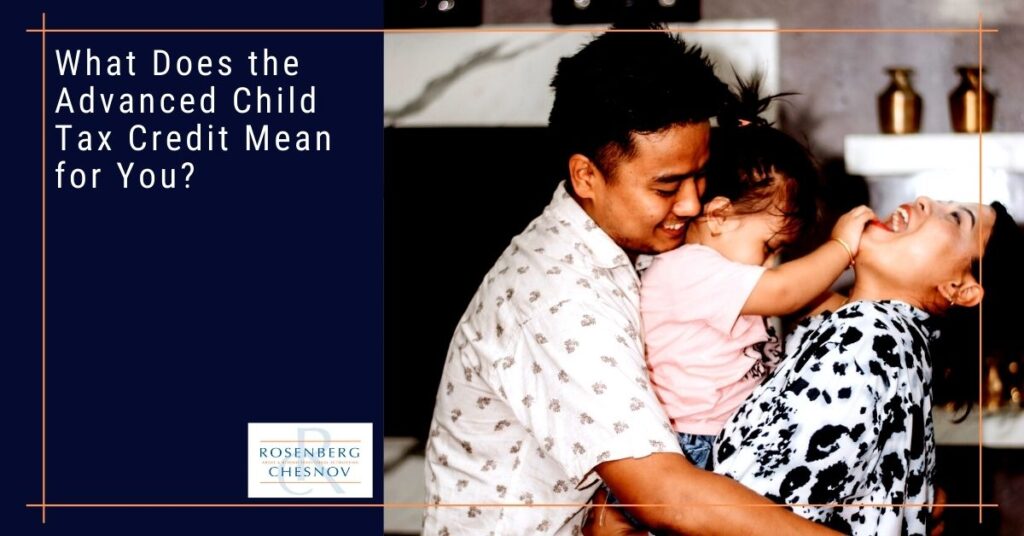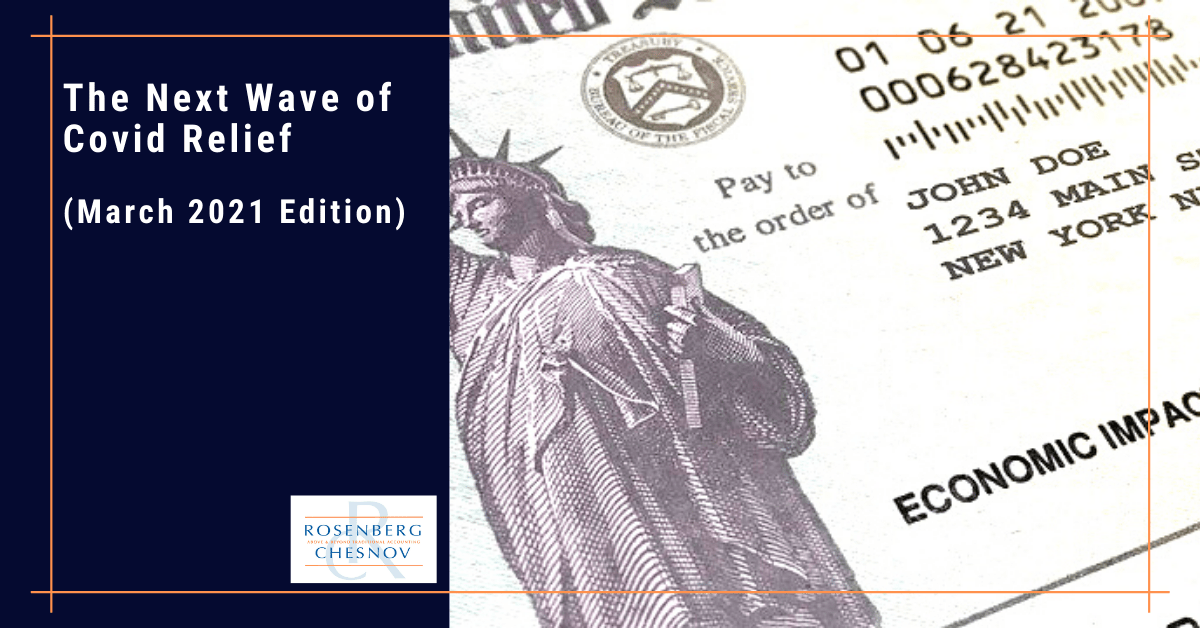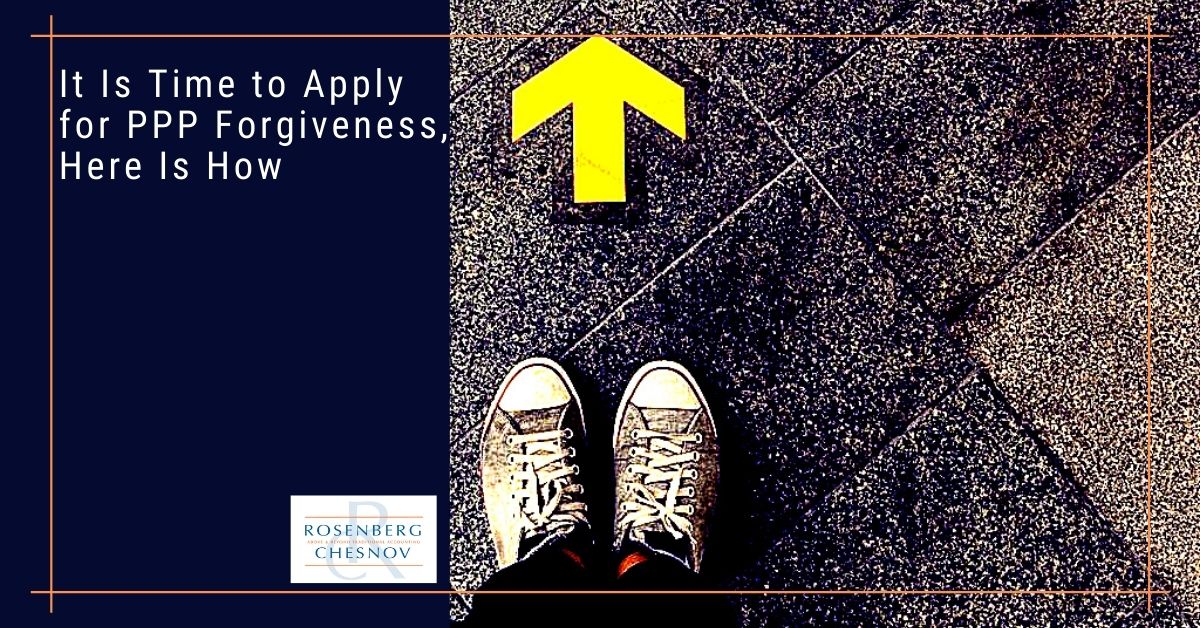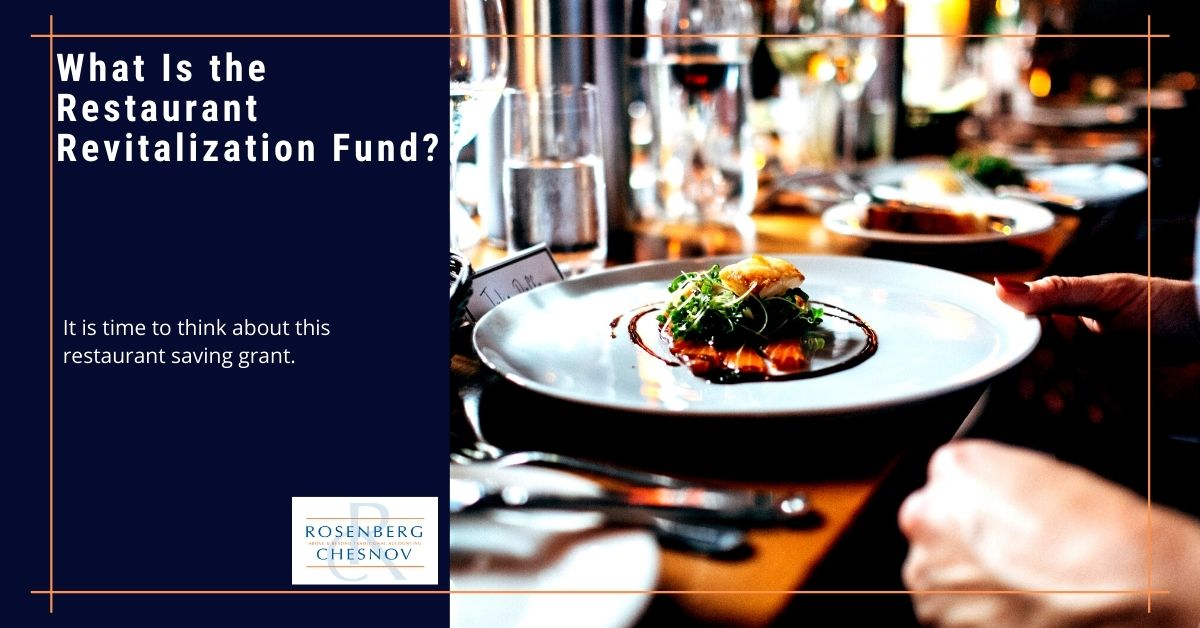

What does the Advance Child Tax Credit mean for you?
Category: COVID-19
The covid relief stimulus bill passed this week is the fourth wave of stimulus enacted over the last year. It is the largest and most aggressive bill yet. It also turns the focus to individuals, families, and states.
The bill does include more stimulus checks and a further extension of unemployment benefits.
There are also several tax changes, including:
There is an increase in healthcare subsidies and support for COBRA payments for those who lost their jobs.
It does not change the PPP loans much at all. However, there are some additional grants for restaurants everywhere and small businesses in low-income communities.
And there are funds to help states fight the pandemic.
Below is a summary of the big items. There is significantly more detail than we can cover in this overview, so if you have any questions, please contact us to discuss.


This round of stimulus includes another stimulus payment of $1,400 per person. Like before, payments are subject to income caps. The phase-out starts at $75,000 per individual, $112,500 for heads of household, and $150,000 for married couples filing jointly.
The phase-out is quick: if you earned more than $80,000 as an individual, $120,000 as head of household, or $160,000 as a married couple, you would not receive any payment at all.
Dependents will also receive $1,400. The last payments included smaller amounts for children up to 15 or 16. This time, the amount is the full $1,400 and includes all dependents regardless of age.
Therefore, a family of 4 with a combined AGI of less than $150,000 will qualify for a $5,600 stimulus check.
Your most recent tax return will determine your income level. If you have already filed your 2020 tax return, the IRS will take your income from that. If you have not filed your 2020 tax return, the IRS will look at your 2019 tax return.
Once the House passes the modified bill and the president signs it, payments should come within a few days.
The bill extends unemployment benefits for another 25 weeks until September 6. The weekly supplemental benefit stays $300 but, rather than ending in March, will run through September 6.
Note that the benefits you receive in 2021 will be taxed unless there is another bill between now and tax time next year that changes the situation.
The child tax credit is more generous for 2021. The credit, which has been worth up to $2,000 per child under 17, increases to $3,600 for children under 5 and $3,000 for children 6 to 17. It also makes the full value of the credit available to low-income people who otherwise qualified for only a portion of the credit.
The child tax credit is for your 2021 taxes, but you may receive some of the payment earlier if you qualify.
There is a provision in the bill that allows for prepayment of the child tax credit during the 2021 calendar year. Exactly how this works is not clear yet. The mechanism to claim this credit does not exist.
The idea, however, is that half of the total credit will be paid to you throughout the year. So, if you would qualify for a $6,000 tax credit in 2021, you would receive monthly payments totaling $3,000 during the calendar year.
If you don’t have children, you may benefit from the earned income credit. The maximum credit for childless people will increase from $543 to $1502, and eligibility will kick in at 19 rather than 25. The bill also eliminates the upper age limit of 65.
This credit is designed to help families pay for care for dependents. It increases the percentage to 50% of eligible expenses (up from 20%), and the total amount increases from $4,000 to $8,000 per eligible dependent.
There is also a significant increase in the income level to qualify. Before, the credit would phase out when your income reached $15,000. For 2021, the phase-out starts at $125,000, and it is a slow phase-out, so even if your income is significantly more, you may qualify for this benefit.
Some people were surprised to learn that unemployment benefits were taxable and faced unexpected tax bills as a result.
The Covid relief bill addresses that at least partially by making the first $10,200 of unemployment payments non-taxable for 2020 only.
Exactly how this will work is unclear: the IRS still has to make the rules. If you already filed your return, you may have to file an amended return, but we don’t know yet.
The COVID relief bill temporarily increases subsidies for people purchasing health insurance through the Affordable Care Act’s marketplaces.
There is also a provision allocating billions of dollars for public health programs and veterans’ health care.
Finally, those who lost their jobs and are on COBRA benefits will get help with their premiums through September. The bill subsidizes up to 100% of COBRA payments.
The PPP program will continue much as it has, with some additional access for non-profits and news organizations.
The deadline for the second draw of the PPP loan is March 31; this has not changed.
Specifically, the legislation makes $15 billion in grants available to businesses in low-income communities with no more than 300 employees.
These businesses must have experienced a 30% decrease in gross receipts over an eight-week period between March 2, 2020, and December 31, 2021, compared to an eight-week period before March 2, 2020.
If you qualify, you will apply through the SBA. However, it may be a few weeks before you can do so since the SBA will have to develop a process.
The bill creates a $25 billion Restaurant Revitalization Fund (RRF) to help businesses in food services.
Food services include restaurants and bars, and food stands, food trucks, food cars, caterers, saloons, inns, taverns, lunges, brewpubs, tasting rooms, taprooms, and any facility in which the patrons gather to be served food or drink.
The grant amount will be equal to a pandemic-related revenue loss of $10 million per entity or $5 million for a physical location.
The calculation is (refreshingly) simple: subtract 2020 revenue from 2019 revenue and apply for the difference.
The legislation provides funding for vaccine distribution, testing, contact tracing, genomic sequencing, and support for governments and schools. Including:
If you are a client and would like to book a consultation, call us at +1 (212) 382-3939 or contact us here to set up a time.
If you aren’t a client, why not? We can take care of your accounting, bookkeeping, tax, and CFO needs so that you don’t have to worry about any of them. Interested? Contact us here to set up a no-obligation consultation.


Category: COVID-19


Category: COVID-19


Category: Accounting
Send us a message and we will contact you as soon as possible.
Send us a message and we will contact you as soon as possible.
Jeff Coyle, CPA, Partner of Rosenberg Chesnov, has been with the firm since 2015. He joined the firm after 20 years of business and accounting experience where he learned the value of accurate reporting, using financial information as a basis for good business decisions and the importance of accounting for management.
He is a diligent financial professional, able to manage the details and turn them into relevant business leading information. He has a strong financial background in construction, technology, consulting services and risk management. He also knows what it takes to create organizations having built teams, grown companies and designed processes for financial analysis and reporting.
His business experience includes:
Creating and preparing financial reporting, budgeting and forecasting.
Planning and preparation of GAAP and other basis financial statements.
Providing insight on financial results and providing advice based on those results.
Jeff also has a long history of helping individuals manage their taxes and plan their finances including:
Income tax planning and strategy.
Filing quarterly and annual taxes.
Audit support.
General financial and planning advice.
Prior to joining the firm in 2015, Jeff was in the private sector where he held senior financial and management positions including Controller and Chief Financial Officer. He has experience across industries, including construction, technology and professional services which gives him a deep understanding of business.
Jeff graduated from Montclair State University, he is a CPA and member of the American Institute of Certified Public Accountants, New York State Society of Certified Public Accountants and New Jersey State Society of Public Accountants.
Jody H. Chesnov, CPA, Managing Partner of Rosenberg Chesnov, has been with the firm since 2004. After a career of public accounting and general management, Jody knows the value of good financials. Clarity, decision making, and strategy all start with the facts – Jody has been revealing the facts and turning them into good business results for more than three decades.
He takes a pragmatic approach to accounting, finance and business. His work has supported many companies on their path to growth, including helping them find investors, manage scaling and overcome hurdles. His experience and passion for business reach beyond accounting and he helps businesses focus on what the numbers mean organizationally, operationally and financially.
He has a particular expertise in early-stage growth companies. His strengths lie in cutting through the noise to come up with useful, out of the box, solutions that support clients in building their businesses and realizing their larger visions.
Prior to joining the firm in 2004, Jody was in the private sector where he held senior financial and management positions including General Manager, Chief Financial Officer and Controller. He has experience across industries, which gives him a deep understanding of business.
Jody graduated with a BBA in Accounting from Baruch College, he is a CPA and member of the American Institute of Certified Public Accountants and New York State Society of Certified Public Accountants.
In addition to delivering above and beyond accounting results, Jody is a member of the NYSCPA’s Emerging Tech Entrepreneurial Committee (ETEC), Private Equity and Venture Capital Committee and Family Office Committee.
He is an angel investor through the Westchester Angels, and has served as an advisor for many startup companies and as a mentor through the Founders Institute.